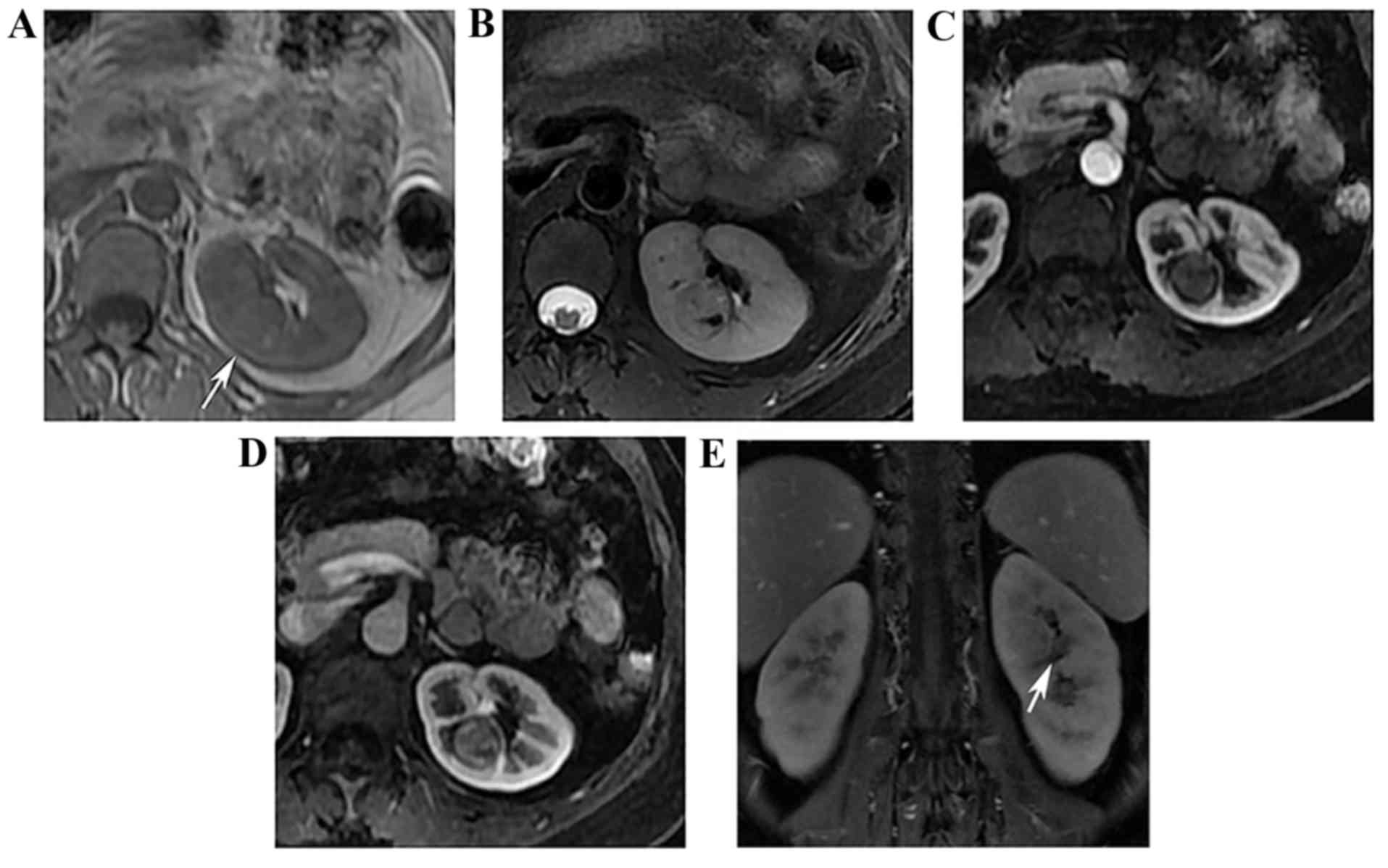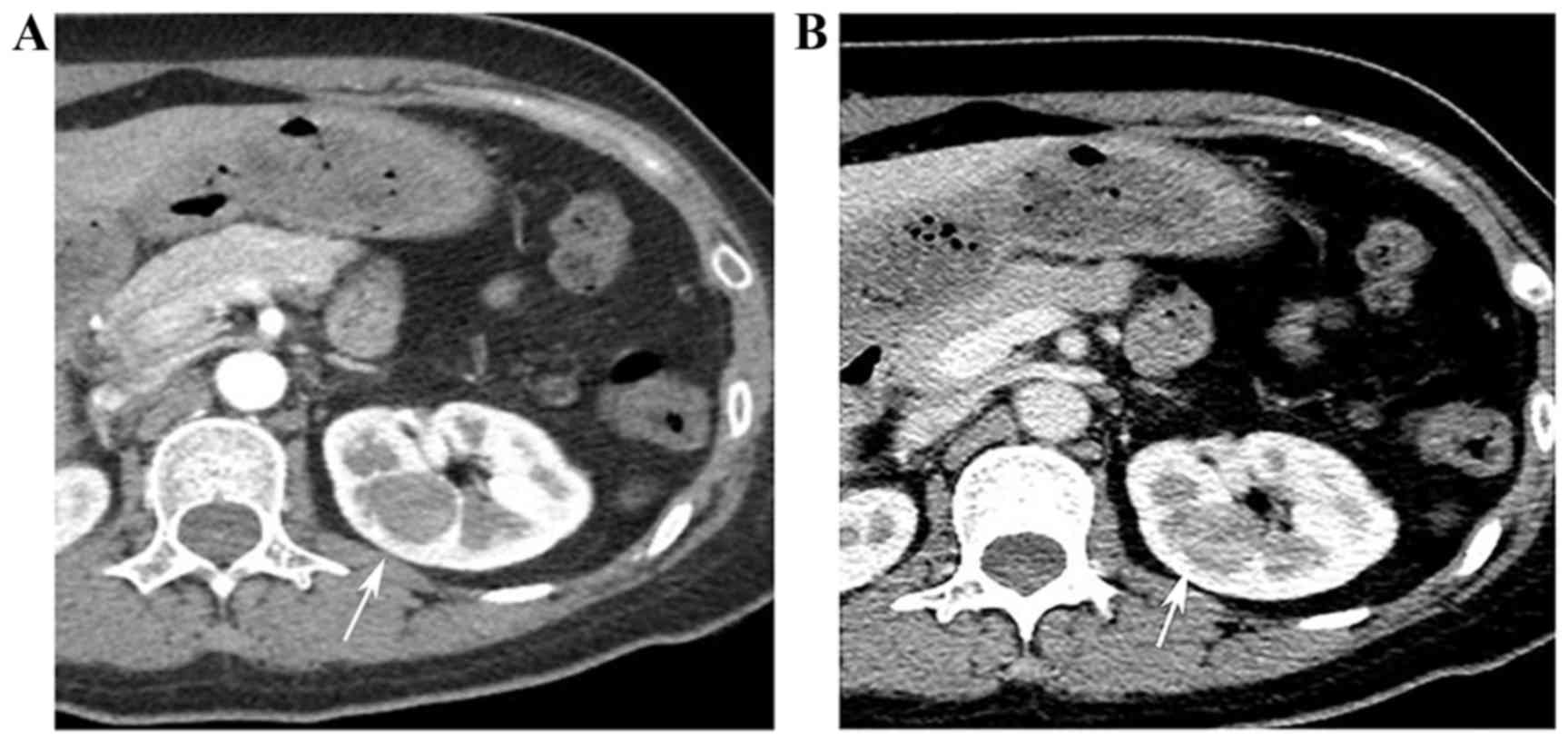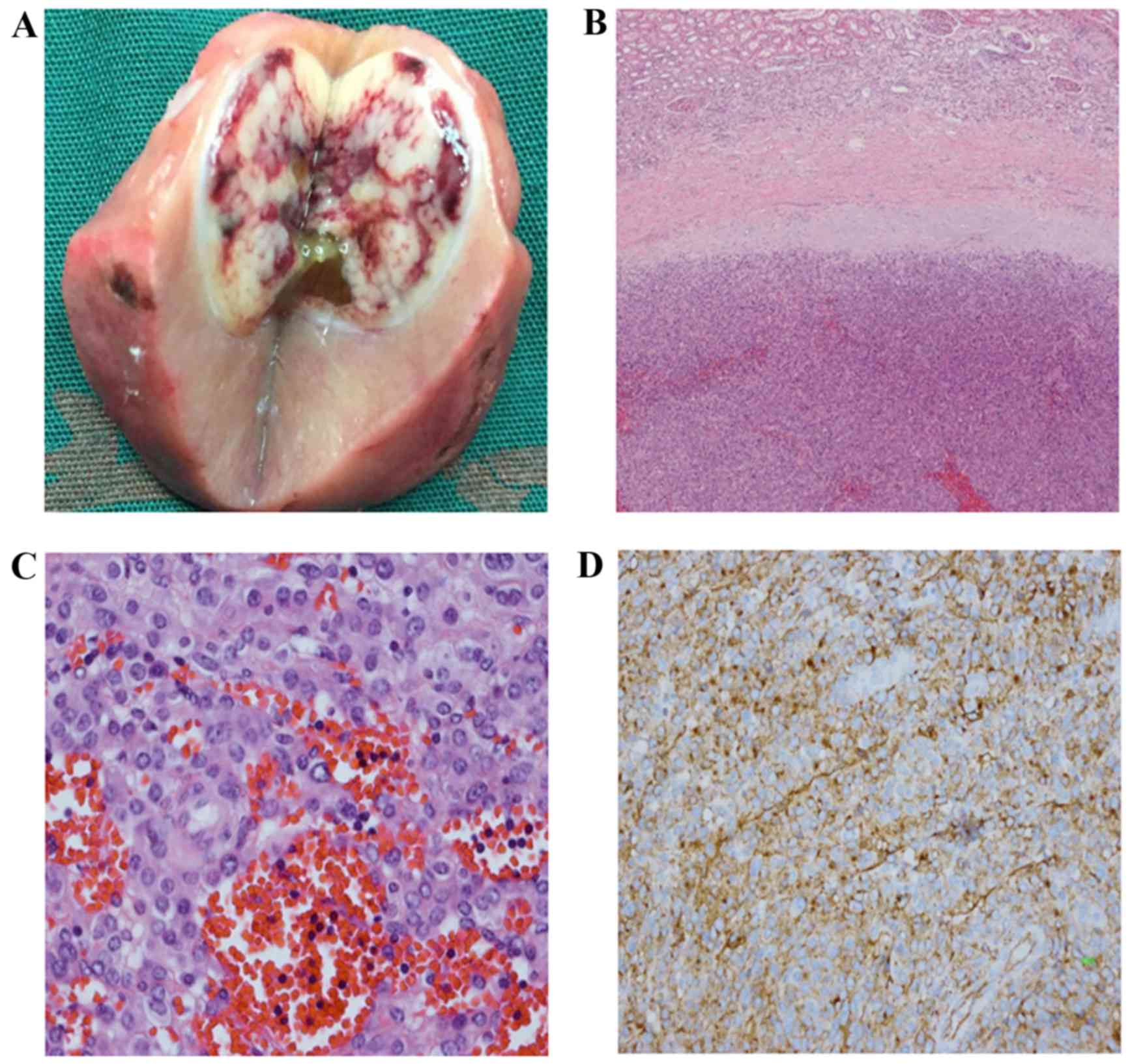Reninoma coexisting with adrenal adenoma during pregnancy: A case report
- Authors:
- Published online on: March 3, 2017 https://doi.org/10.3892/ol.2017.5802
- Pages: 3186-3190
Abstract
Introduction
Reninomas, or renal juxtaglomerular cell tumors, develop within the juxtaglomerular apparatus through the evolution of small artery smooth muscle cells. These tumor cells produce excessive amounts of renin that results in severe hypertension with hypokalemia and hyperaldosteronism, through the activity of the renin-angiotensin aldosterone system (1). It is a rare form of secondary hypertension. Removing the reninoma results in the conversion of increased blood pressure to normal blood pressure (2). Therefore, perioperative hemodynamic management is important in patients who undergo surgery for the removal of a reninoma.
Adrenal adenoma is a benign neoplasm, which is derived from cells of the adrenal cortex, and may be functionally active or nonfunctional (3). Functional adrenal adenoma is able to cause aldosteronism or Cushing's syndrome. Primary aldosteronism (PA) is characterized by autonomous aldosterone production, which is a cause of secondary hypertension (4). Evidence has developed over the past decades and led to the recognition that autonomous adrenal aldosterone production, termed primary aldosteronism, is common in hypertensive patients. Between 5 and 13% of patients with hypertension have primary aldosteronism (5).
The present study reported a rare case of reninoma coexisting with an adrenal adenoma in a young female with secondary hypertension during pregnancy.
Case report
A 2.5-cm mass was detected on the right adrenal gland of a 31-year-old pregnant female with hypertension in her 33rd gestational week by an ultrasound scan. The patient presented with a personal history of elevated blood pressure (BP) for several months prior to conception, and exhibited a family history of hypertension. There were no other abnormalities found by the ultrasounds of the adrenal gland and the renal artery, therefore the patient was diagnosed with primary hypertension. The BP levels of the patient were uncontrolled during pregnancy. In the 35th+6 gestational week, the patient underwent surgical termination of the pregnancy due to uncontrolled hypertension, with delivery of a viable fetus. The BP of the patient fluctuated between 140 and 177/90 and 115 mmHg subsequent to the termination of the pregnancy. An abdominal magnetic resonance imaging (MRI) scan and an ultrasound were performed 1 month subsequent to the termination of the pregnancy.
The MRI was performed and showed an oval-shaped mass on the right adrenal gland, as exhibited in Fig. 1. The mass was recorded as a hyperintensity region on the T2 weighted-image (T2WI), and showed a marked heterogeneous enhancement during the arterial phase and a homogeneous enhancement during the venous phase, which was considered typical of an adrenal adenoma. In addition, a small well-defined solid mass was found on the left kidney, which is demonstrated in Fig. 2. The lesion was recorded as isointense on the T1 weighted-image (T1WI) with a spot hyperintensity area, and was hyperintense on T2WI. The mass was not markedly enhanced during the arterial phase, and was slightly enhanced during the venous phase. The mass was observed to be isointense during the delay phase.
An ultrasound scan detected a clear hypoechoic mass on the right adrenal gland. However, a diagnosis of the lesion on the left kidney was not reached. The clinical diagnosis was functional adrenocortical adenoma, primary aldosteronism (PA), and a potentially malignant left renal tumor. The surgical team removed the right adrenal neoplasm first, and removed the left renal tumor subsequent to two months. The patient underwent a laparoscopic right adrenalectomy to remove the right adrenal neoplasm. Pathological analysis revealed that the neoplasm was an adrenocortical adenoma. However, the BP levels of the patient did not return to normal subsequent to the operation.
A total of 2 months later, a follow-up computed tomography (CT) angiography scan revealed normal renal arteries, but confirmed the presence of a 2.2-cm mass in the left kidney, as exhibited in Fig. 3. The mass showed no marked enhancement during the arterial phase, and a slight enhancement during the portal venous phase. There was no change in the size of the lesion. The patient underwent a laparoscopic left partial nephrectomy to remove the lesion on the left kidney. The surgical procedure was successful, with no intraoperative or postoperative complications. The BP of the patient showed a substantial reduction from 177/115 to 125/80 mmHg on the day subsequent to surgery, and stabilized to be within the normal range. As a result, all antihypertensive therapies were discontinued 1 week later. The BP of the patient remained in the normal range subsequent to a 6-month follow-up.
Gross examination of the left partial nephrectomy sample showed a solitary, well-circumscribed tumor measuring 2 cm, with a grey-white colored section and some areas of hemorrhage, as demonstrated in Fig. 4A. The histological analysis revealed that the tumor cells were arranged solidly, or as amorphous plaques, exhibiting clear borderlines with the renal cortex (Fig. 4B). The tumor was composed of round and polygonal cells with eosinophilic cytoplasm, and regular cell nuclei and perinuclear halos were observed (Fig. 4C). During immunohistochemical analysis, the round uniform cells were stained and produced a strong positive result for the presence of the vascular marker cluster of differentiation (CD)34 (Fig. 4D), and a negative result for the presence of keratin AE1 andAE3, smooth muscle actin, chromogranin A, Syn, RCC, HMB45, S100, CD31 and Ki-67 markers. In conjunction with the clinical history, the histological findings and immunohistochemical analysis supported a diagnosis of reninoma.
Discussion
Reninoma is a benign neoplasm that produces renin and results in secondary hypertension with hyperaldosteronism and hypokalemia. Occasionally, the tumors exhibit malignant behavior (6–9). The incidence of reninoma is low: Since the first description in 1967 by Robertson et al (10), ~100 cases have been reported, the majority of which occur in young adult females with a mean age of 27 years (11).
Among the number of reninoma cases reported (12–17), the patient of the present study case is the 7th study reporting a patient with reninoma during pregnancy. According to previous studies, the majority of reninomas present in the form of solitary tumor (11,18). The coexistence of reninoma and bilateral pheochromocytoma has been previously reported (19), whereas the present study is the first case report of reninoma coexisting with an adrenal adenoma.
There are many data suggesting that secondary hypertension may be caused by several conditions, affecting the kidneys, heart, arteries or endocrine system. Common causes include renovascular hypertension, PA and pheochromocytoma (20). PA is considered to be the major common cause of secondary hypertension (21), which results from the inappropriate endogenous production of the mineralocorticoid aldosterone by the adrenal glands. The condition is also caused by solitary or multifocal aldosterone-producing adenomas, or less commonly by adrenal gland hyperplasias (22). As the patient in the present study exhibited neoplasms in the right adrenal gland and in the left kidney, the hypertension was presumed a result of PA, which was incorrect.
It is difficult to accurately diagnose the pathogeny of hypertension based solely on radiology imaging; lab examination is effective in achieving a correct diagnosis. Reninoma and PA are associated with hypokalemia, hyperaldosteronism and hypertension. Reninoma produce excessive amounts of renin, which results in secondary hyperaldosteronism, with the plasma renin levels remaining normal in PA patients (23). The level of hypertension of the patient was mistakenly linked to the right adrenal tumor when the patient was referred to the Chinese Academy of Medical Sciences Cancer Institute and Hospital (Beijing, China) prior to testing the level of renin. Retrospective analyses of the medical examinations of the patient were carried out by the Beijing Shijitan Hospital (Beijing, China), where the patient gave birth, and demonstrated that the renin level of the patient of the present study was clearly higher than the normal range, which provides additional evidence to support the hypothesis that the neoplasm in the left kidney of this patient was a reninoma. The laboratory examinations demonstrated hypokalemia, with levels of serum potassium measuring 3.48 mmol/l, whereas the normal range is 3.5–5.3 mmol/l. Plasma renin, angiotensin II and aldosterone levels were elevated in the supine and upright positions (renin: 19.40 and 24.30 ng/ml/h; angiotensin II: 370.20 and 425.30 pg/ml; aldosterone: 19.22 and 27.18 ng/dl), demonstrating that laboratory tests are useful for differential diagnosis.
Reninomas are difficult to identify with ultrasound technology, even in cases of known renal lesion. Therefore, if a reninoma is suspected, particularly in females with severe hypertension, CT or MRI scans may be considered as the primary diagnostic tool for screening renal tumors, in comparison with ultrasound scans. Small isodense lesions may not be detected by unenhanced CT scans: Therefore, enhanced CT scans may be performed for all suspected cases (18). Rosei et al (24) reported that CT scans are particularly sensitive at detecting this kind of tumor compared with MRI scans, as MRI scans may produce misleading results.
The radiological features of reninoma have been documented, presenting as hypo- or isodense solid masses with well-defined borders on an unenhanced CT scan, and remaining hypovascular on arterial phase images due to the vasoconstriction caused by the renin excreted from the tumor. Results from the MRI T1-weighted images demonstrate tumors in iso- or hypointense areas, whilst on the T2-weighted images they appear as hyperintense (25).
In conclusion, the present study described a rare case of reninoma coexisting with an adrenal adenoma during pregnancy. Reninoma should be included in the differential diagnoses of incidences of solitary regular renal masses with a slight enhancement in patients with hypertension, particularly in young females. Enhanced CT and MRI scans should be performed when reninoma is suspected. In addition, laboratory tests are highly recommended in differentiating reninoma.
Glossary
Abbreviations
Abbreviations:
|
T2WI |
T2 weighted-image |
|
T1WI |
T1 weighted-image |
|
PA |
primary aldosteronism |
References
|
Corvol P, Pinet F, Plouin PF, Bruneval P and Menard J: Renin-secreting tumors. Endocrinol Metab Clin North Am. 23:255–270. 1994.PubMed/NCBI | |
|
Dong D, Li H, Yan W, Xu W, Lu L and Zeng Z: The diagnosis and surgical anagement of juxtaglomerular cell tumor of the kidney. J Hypertens. 28:628–632. 2010. View Article : Google Scholar : PubMed/NCBI | |
|
Szejnfeld D, Nunes TF, Giordano EE, Freire F, Ajzen SA, Kater CE and Goldman SM: Radiofrequency ablation of functioning adrenal adenomas: Preliminary clinical and laboratory findings. J Vasc Interv Radiol. 26:1459–1464. 2015. View Article : Google Scholar : PubMed/NCBI | |
|
Rayner B: Primary aldosteronism and aldosterone-associated hypertension. J Clin Pathol. 61:825–831. 2008. View Article : Google Scholar : PubMed/NCBI | |
|
Rossi GP, Bernini G, Caliumi C, Desideri G, Fabris B, Ferri C, Ganzaroli C, Giacchetti G, Letizia C, Maccario M, et al: A Prospective study of the prevalence of primary aldosteronism in 1,125 hypertensive patients. J Am Coll Cardiol. 48:2293–2300. 2006. View Article : Google Scholar : PubMed/NCBI | |
|
Shera AH, Baba AA, Bakshi IH and Lone IA: Recurrent malignant juxtaglomerular cell tumor: A rare cause of malignant hypertension in a child. J Indian Assoc Pediatr Surg. 16:152–154. 2011. View Article : Google Scholar : PubMed/NCBI | |
|
Duan X, Bruneval P, Hammadeh R, Fresco R, Eble JN, Clark JI, Vigneswaran WT, Flanigan RC and Picken MM: Metastatic juxtaglomerular cell tumor in a 52-year-old man. Am J Surg Pathol. 28:1098–1102. 2004. View Article : Google Scholar : PubMed/NCBI | |
|
Beaudoin J, Périgny M, Têtu B and Lebel M: A patient with a juxtaglomerular cell tumor with histological vascular invasion. Nat Clin Pract Nephrol. 4:458–462. 2008. View Article : Google Scholar : PubMed/NCBI | |
|
Dong D, Li H, Yan W and Xu W: Juxtaglomerular cell tumor of the kidney-a new classification scheme. Urol Oncol. 28:34–38. 2010. View Article : Google Scholar : PubMed/NCBI | |
|
Robertson PW, Klidjian A, Harding LK, Walters G, Lee MR and Robb-Smith AH: Hypertension due to a renin-secreting renal tumour. Am J Med. 43:963–976. 1967. View Article : Google Scholar : PubMed/NCBI | |
|
Wong L, Hsu TH, Perlroth MG, Hofmann LV, Haynes CM and Katznelson L: Reninoma: Case report and literature review. J Hypertens. 26:368–373. 2008. View Article : Google Scholar : PubMed/NCBI | |
|
Henderson NL and Mason RC: Juxtaglomerular cell tumor in pregnancy. Obstet Gynecol. 98:943–945. 2001. View Article : Google Scholar : PubMed/NCBI | |
|
Kim HJ, Kim CH, Choi YJ, Ayala AG, Amirikachi M and Ro JY: Juxtaglomerular cell tumor of kidney with CD34 and CD117 immunoreactivity: Report of 5 cases. Arch Pathol Lab Med. 130:707–711. 2006.PubMed/NCBI | |
|
Lachvac L, Svajdler M, Valansky L, Nagy V, Benicky M, Frohlichova L and Nyitrayova O: Juxtaglomerular cell tumor, causing fetal demise. Int Urol Nephrol. 43:365–370. 2011. View Article : Google Scholar : PubMed/NCBI | |
|
Shin YS, Cha JS, Kang MJ, Park JK, Kim HJ and Kim MK: Newly developed hypertension due to juxtaglomerular cell tumor in pregnancy. Clin Nephrol. 78:325–327. 2012. View Article : Google Scholar : PubMed/NCBI | |
|
Ohashi Y, Kobayashi S, Arai T, Nemoto T, Aoki C, Nagata M and Sakai K: Focal segmental glomerulosclerosis secondary to juxtaglomerular cell tumor during pregnancy: A case report. Case Rep Nephrol Urol. 4:88–94. 2014. View Article : Google Scholar : PubMed/NCBI | |
|
Diker-Cohen T, Abraham SB, Rauschecker M, Papadakis GZ, Munir KM, Brown E, Lyssikatos C, Belyavskaya E, Merino M and Stratakis CA: Reninoma presenting in pregnancy. J Clin Endocrinol Metab. 99:2625–2626. 2014. View Article : Google Scholar : PubMed/NCBI | |
|
Gottardo F, Cesari M, Morra A, Gardiman M, Fassina A and Dal Bianco M: A kidney tumor in an adolescent with severe hypertension and hypokalemia: An uncommon case-case report and review of the literature on reninoma. Urol Int. 85:121–124. 2010. View Article : Google Scholar : PubMed/NCBI | |
|
Paragliola RM, Capoluongo E, Torino F, Minucci A, Canu G, Prete A, Pontecorvi A and Corsello SM: A rare case of juvenile hypertension: Coexistence of type 2 multiple endocrine neoplasia-related bilateral pheochromocytoma and reninoma in a young patient with ACE gene polymorphism. BMC Endocr Disord. 15:302015. View Article : Google Scholar : PubMed/NCBI | |
|
Baglivo HP and Sánchez RA: Secondary arterial hypertension: Improvements in diagnosis and management in the last 10 years. Am J Ther. 18:403–415. 2011. View Article : Google Scholar : PubMed/NCBI | |
|
Young WF: Primary aldosteronism: Renaissance of a syndrome. Clin Endocrinol (Oxf). 66:607–618. 2007. View Article : Google Scholar : PubMed/NCBI | |
|
Layden BT, Hahr AJ and Elaraj DM: Primary hyperaldosteronism: Challenges in subtype classification. BMC Res Notes. 5:6022012. View Article : Google Scholar : PubMed/NCBI | |
|
Kim SH, Ahn JH, Hong HC, Choi HY, Kim YJ, Kim NH, Yoo HJ, Kim HY, Seo JA, Kim NH, et al: Changes in the clinical manifestations of primary aldosteronism. Korean J Intern Med. 29:217–225. 2014. View Article : Google Scholar : PubMed/NCBI | |
|
Rosei CA, Giacomelli L, Salvetti M, Paini A, Corbellini C, Tiberio G and Muiesan ML: Advantages of renin inhibition in a patient with reninoma. Int J Cardiol. 187:240–242. 2015. View Article : Google Scholar : PubMed/NCBI | |
|
Karaosmanoğlu AD, Onur MR, Shirkhoda A, Ozmen M and Hahn PF: Unusual benign solid neoplasms of the kidney: Cross-sectional imaging findings. Diagn Interv Radiol. 21:376–381. 2015. View Article : Google Scholar : PubMed/NCBI |













